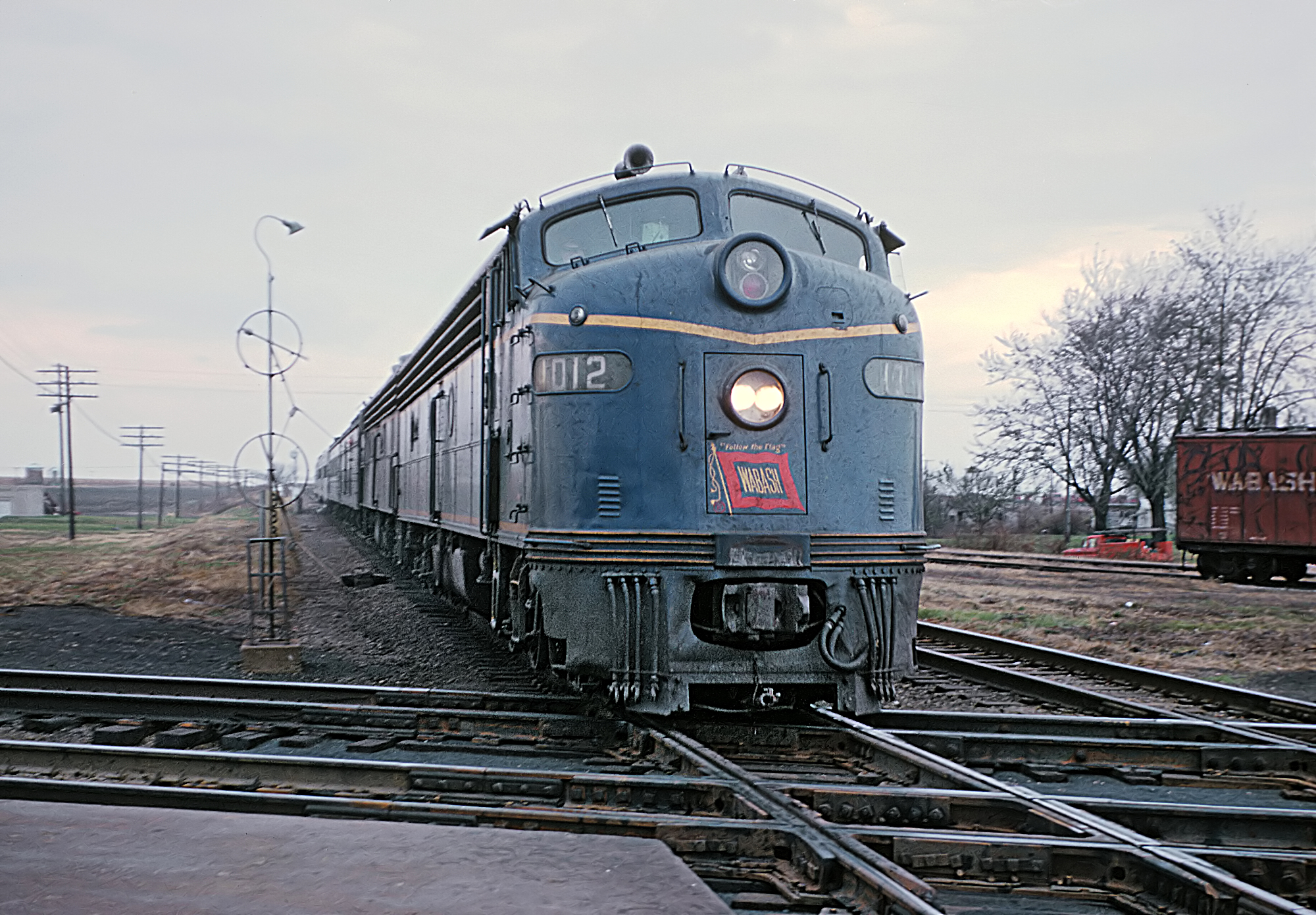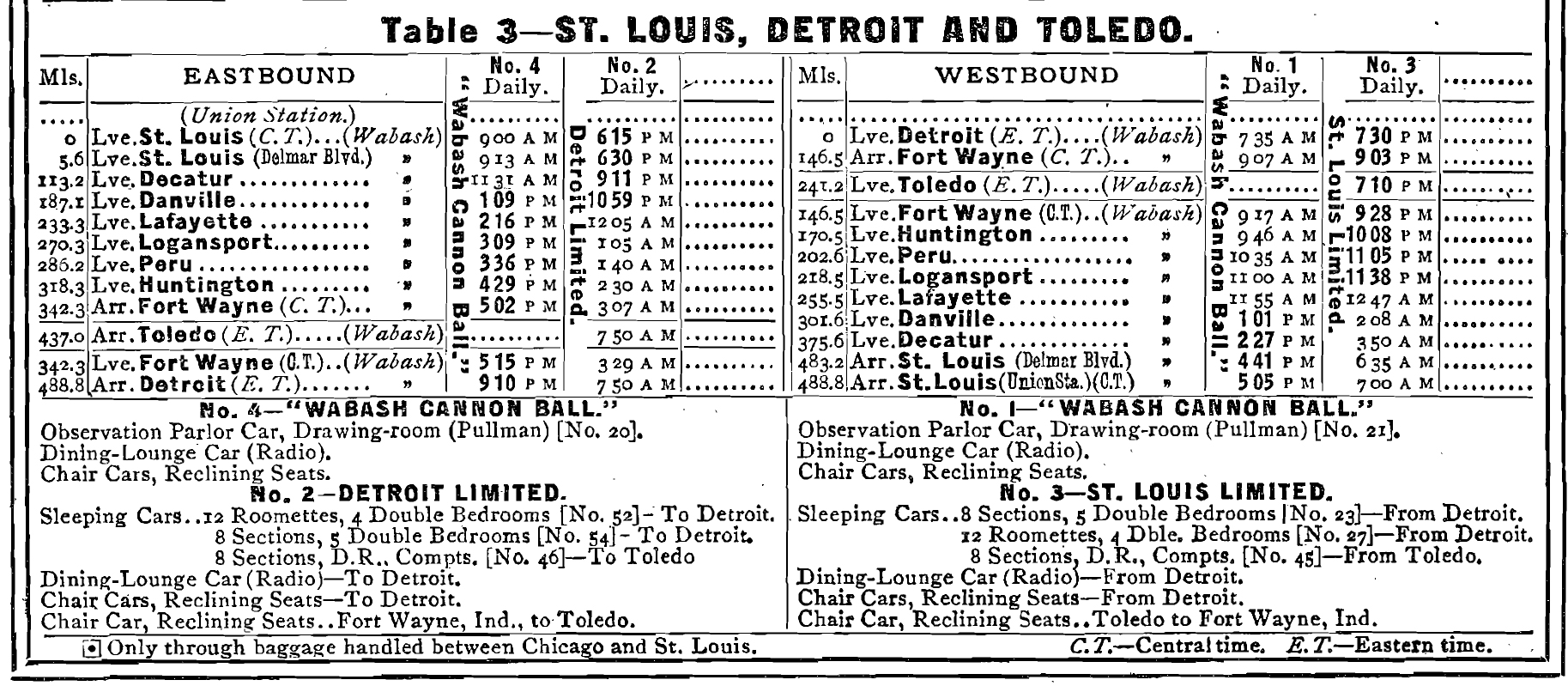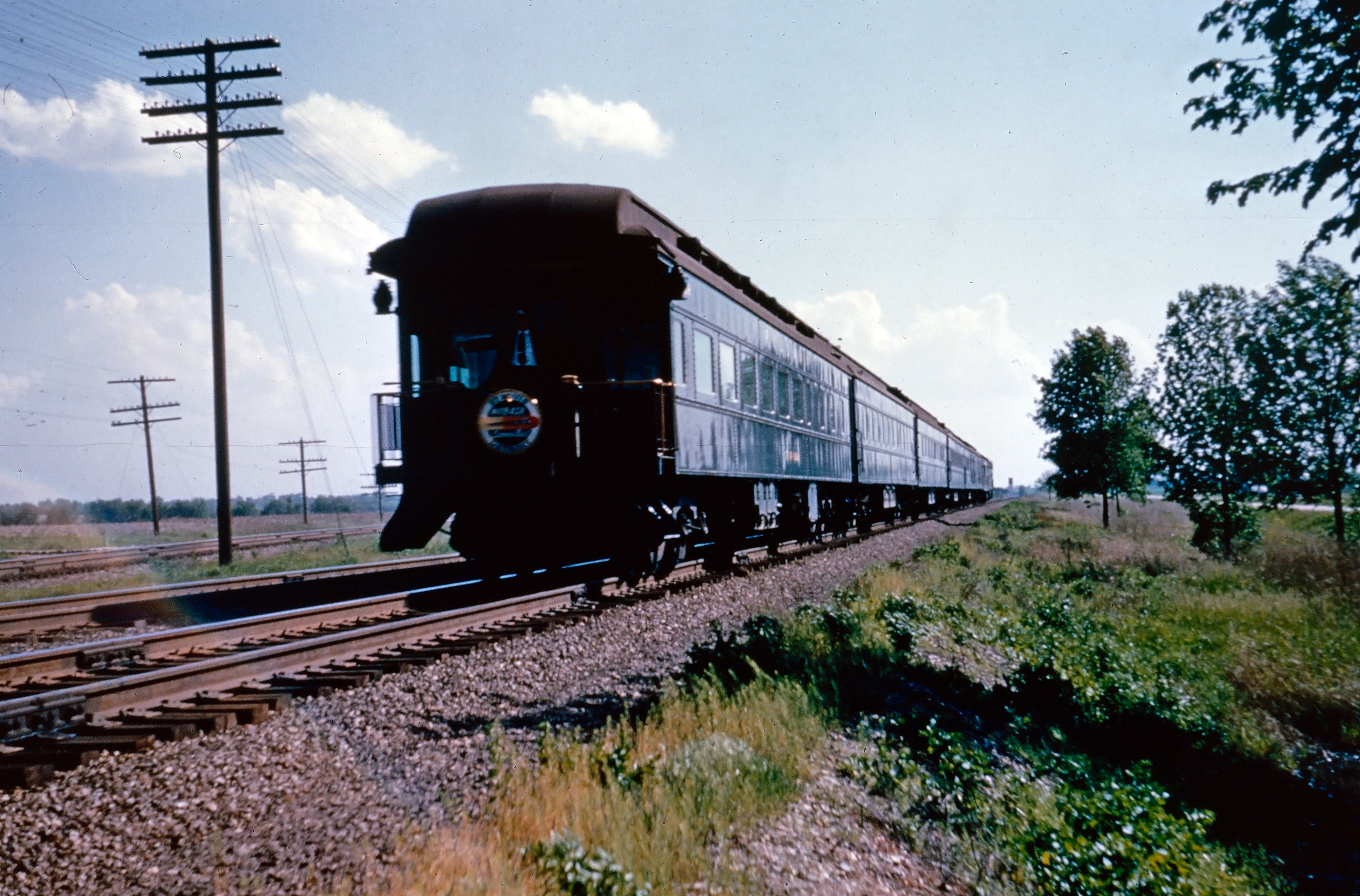The "Wabash Cannon Ball"
Last revised: September 15, 2024
By: Adam Burns
The Wabash Cannon Ball was a fast express train on the Wabash Railroad, and continued by successor Norfolk and Western.
Named after the popular folk song, it operated from 1950 to 1971, providing passenger service between Detroit, Michigan, and St. Louis, Missouri. The train was known for its speed and luxury, featuring amenities such as air conditioning, dining cars, and sleeping quarters.
While the origins of this name can be traced as far back as the 19th century, the modern incarnation was launched in 1950 following the folk song's popularity.
Photos
 Wabash E8A #1012 has train #4, the eastbound "Wabash Cannon Ball," arriving at Tolono, Illinois on October 28, 1962. Roger Puta photo.
Wabash E8A #1012 has train #4, the eastbound "Wabash Cannon Ball," arriving at Tolono, Illinois on October 28, 1962. Roger Puta photo.Inauguration
In his book, "More Classic American Railroads," author Mike Schafer notes the Wabash first attached the name Wabash Cannon Ball to its Detroit-St. Louis day trains in 1949. It was the first time the railroad had applied the moniker to an actual train.
Embarking on a breathtaking journey across the heart of the Wabsh system from St. Louis to Detroit. This route was meticulously designed, crossing a unique tapestry of landscapes that encapsulated the heart and spirit of America.
The inception of the Wabash Cannon Ball was intriguingly linked with the popular song "Wabash Cannonball". The song was recorded by various artists over the decades, including Roy Acuff, who notably popularized it in 1936.
Accommodations
Its widespread success stirred the creative wheels at the Wabash, which christened its passenger train service after the song, thus engraining the Wabash Cannon Ball into the physical and cultural landscape of the country.
Aboard the train, passengers were treated to a variety of services aimed at ensuring a pleasant and memorable journey. The on-board accommodations were modest but quite comfortable. In 1952 they included an observation parlor (with drawing room), a diner-lounge, chair cars, and reclining seat coaches.
From comfortable seating in both coach and first-class cars to exquisite dining service, each ride on the Wabash Cannon Ball encapsulated an exciting voyage across the American Midwest.
The train made several stops along its 488.8 mile route including Fort Wayne, Huntington, Peru, Logansport, Lafayette, Danville, and Decatur while arrivals and departure occurred at St. Louis Union Station and Detroit's Fort Street Union Depot. As an eastbound train, it bore number 4, while its westbound counterpart was designated number 3.
Timetable and Consist (1952)

Norfolk & Western
The Wabash Cannon Ball owed a substantial part of its existence to the Detroit Special and the St. Louis Special. These predecessor trains laid the groundwork, fostering the route and logistical infrastructure necessary for the launch and continuance of the Wabash Cannon Ball.
On October 16, 1964 the Norfolk & Western acquired the Wabash. Despite the transition in ownership, and the N&W's attempts to discontinue the train's name in the mid 1960s - as well as the service itself a few years later - public outcry saved the Cannon Ball until the start of Amtrak.
The turn of the decade came with the end of an era. The Wabash Cannon Ball ceased operations on April 30, 1971. While the exact date marked the closure of a remarkable journey, it also opened new avenues of nostalgia, legacy, and historical preservation.
Legacy
The Wabash Cannon Ball, much like its celebrated name, was a testament to the harmonious blend of culture and technology. Its legacy outlasted its operational span, as the grandeur of its historical voyage continued to captivate the imagination of railroad enthusiasts and historians alike.
While its services were modest it nevertheless painted a picture of luxurious travel. On this legendary train, the journey was just as immersive as the destination, with each voyage transforming into a delightful rendezvous with comfort and elegance.
At its heart, the Wabash Cannon Ball was a cultural phenomenon. Its existence, spurred by a popular song, catapulted a routine train service into a living embodiment of public sentiment and regional pride.
Its connection with St. Louis and Detroit - a manufacturing powerhouse and a gateway to the west respectively - allowed it to stitch together the disparate economies and fostered a sense of unity amongst its travelers.
Despite operating for just under three decades, the Wabash Cannon Ball’s importance to American railroad history remains undiminished. Its service, span, and cultural significance have sealed its place within the annals of the country's rich rail history.
It was not just a train, but a symbol of an era. It represented the seamless intertwining of technology and human spirit, the embracing of progress, and nostalgia for a simpler past.
As a precursor to the Norfolk and Western's acquisition, the train played a significant role in setting the stage for transformative changes in regional and intra-city train services – an inspiration that continues to resonate within the industry today.
The train's namesake song, the "Wabash Cannonball," continues to act as a melodic metaphor for the train’s legacy. Its rhythmic testament to the train's flamboyance, resilience and grandeur embellishes the narrative of the train.
The Wabash Cannon Ball, while no longer thundering across the tracks, lives on in the collective memory of America. The distinct rhythm of tracks under its wheels, the echoing whistle cutting through the heartland, the sight of its streamlined form rushing towards the next destination – all continue to inspire artists and storytellers.
The train's end was not spurred by a decline in popularity or practicality but was a consequence of larger industry-wide shifts towards modernized, high-speed services. This, combined with rising operational costs and decreasing profit margins, led to its eventual retirement.
In September, 1967 the U.S. Postal Service ended all "mail by rail" contracts, and instead moved this freight by either truck or air lines. It was the final blow to privately operated passenger rail services as most of the industry wanted out, which led to Amtrak's creation on May 1, 1971.
 The heavyweight observation-parlor brings up the tail end of the "Wabash Cannon Ball" at Litchfield, Illinois on May 4, 1955. Photographer unknown. American-Rails.com collection.
The heavyweight observation-parlor brings up the tail end of the "Wabash Cannon Ball" at Litchfield, Illinois on May 4, 1955. Photographer unknown. American-Rails.com collection.Through its service, the Wabash Cannon Ball underlined the importance of connectivity. It played an integral role in economic functions by transporting goods and passengers, spurred social connections by moving people across states, and provided a platform for the shared cultural experience of traversing America.
In summary, the Wabash Cannon Ball's significance persists in its symbolization of rail travel's romantic era. Through its network, services, and culture, it ensured that the essence of the journey exceeded the destination.
From its memorialization in song to its tangible imprint on American railroads, the train remains an iconic testament to the power and majesty of trains.
Sources
- Grant, Roger H. "Follow The Flag": A History Of The Wabash Railroad Company. DeKalb: Northern Illinois University Press, 2004.
- Heimburger, Donald J. Wabash. Forest Park: Heimburger House Publishing Company, 1984.
- Schafer, Mike. More Classic American Railroads. Osceola: MBI Publishing, 2000.
- Schafer, Mike and Welsh, Joe. Streamliners, History of a Railroad Icon. St. Paul: MBI Publishing, 2003.
Recent Articles
-
Rio Grande 2-8-2 Locomotives (K-37): Specs, Roster, Photos
Apr 15, 25 12:57 PM
Rio Grande's Class K-37 Mikes were itsdge steamers to enter service in the late 1920s. Today, all but two survive. -
Rio Grande 2-8-2 Locomotives (K-36): Specs, Roster, Photos
Apr 15, 25 11:09 AM
The Rio Grande's K-36 2-8-2s were its last new Mikados purchased for narrow-gauge use. Today, all but one survives. -
Rio Grande 2-8-2 Locomotives (Class K-28): Specs, Roster, Photos
Apr 14, 25 10:24 PM
Rio Grande's Class K-28 Mikados were its newest narrow-gauge steam locomotives since the Mudhens of the early 1900s. Today, three survive.


